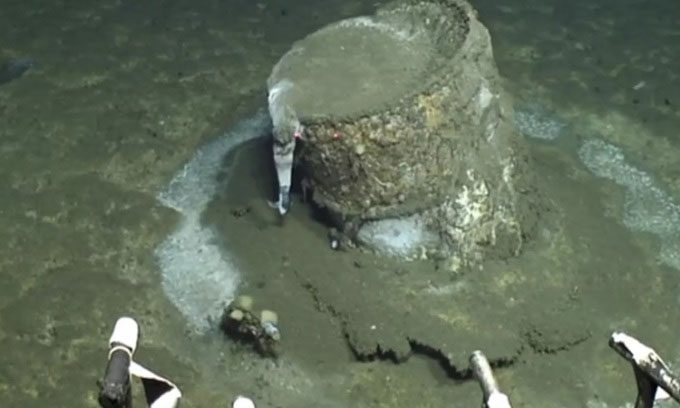Thousands of barrels decaying on the ocean floor off the coast of Los Angeles may contain radioactive waste including tritium and carbon-14.
Researchers at the University of California, Santa Barbara, initially believed the barrels contained the pesticide Dichlorodiphenyltrichloroethane (DDT), but recent findings indicate that they may actually hold radioactive waste, specifically tritium and carbon-14, according to a paper published on February 21 in the journal Environmental Science & Technology.

Rusting waste containers at a depth of 91 meters underwater near Santa Catalina Island. (Photo: David Valentine / ROV Jason).
For decades, a graveyard of rusting barrels has been scattered across the ocean floor off Los Angeles. This graveyard remained out of sight and did not become a haunting secret until a team of researchers discovered the area using advanced underwater cameras. Speculation arose about the contents of these mysterious barrels. The substantial presence of DDT near the barrels unveiled a little-known history of toxic pollution from the largest domestic producer of DDT, but federal authorities recently determined that the company is not linked to these barrels as their waste was discharged directly into the ocean, according to the Los Angeles Times.
Currently, scientists conclude that the barrels may contain low-level radioactive waste. Documentation shows that from the 1940s to the 1960s, hospitals, laboratories, and various industrial facilities discharged barrels containing tritium, carbon-14, and similar waste into the ocean.
David Valentine’s research team was the first to discover the barrel graveyard and raise concerns about its contents. In a study published this week, Valentine found that the density of DDT was spread across the seafloor area larger than the city of San Francisco.
Valentine’s team collected hundreds of sediment samples in a large-scale effort to map pesticide dumping activities, analyzing how chemicals could move in water and whether they would break down. After several ocean expeditions, they have yet to find the boundaries of the chemical dumping site but concluded that most of the DDT in the deep sea remains in its strongest form.
Further analysis using carbon dating methods indicated that DDT dumping peaked in the 1950s when Montrose Chemical Corporation in California was operational near Torrance, during the height of pesticide usage and before formal regulations on ocean waste disposal were established.
Jacob Schmidt, the lead researcher working in Valentine’s lab, sifted through hundreds of pages of old documents and uncovered evidence revealing that California Salvage, the company authorized to dump DDT in the waters off Los Angeles, also dumped low-level radioactive waste into the sea. Although the company ceased this activity, it had received a permit in 1959 to dump radioactive waste contained in barrels approximately 240 kilometers offshore. Despite records from the U.S. Atomic Energy Commission showing that the permit was never valid, California Salvage continued to advertise its nuclear waste disposal services and reportedly accepted waste in the 1960s from a radioactive isotope facility in Burbank, as well as containers of carbon-14 from local hospitals.
According to Ken Buesseler, a marine radiochemist not involved in the research, some radioactive isotopes dumped into the ocean during that time, such as tritium, may have mostly decayed over the past 80 years. However, there are many questions about other isotopes that could be more dangerous. He referred to an old map from the International Atomic Energy Agency indicating that from 1976 to 1970, over 56,000 barrels of nuclear waste were dumped into the Pacific Ocean in U.S. territories.


















































